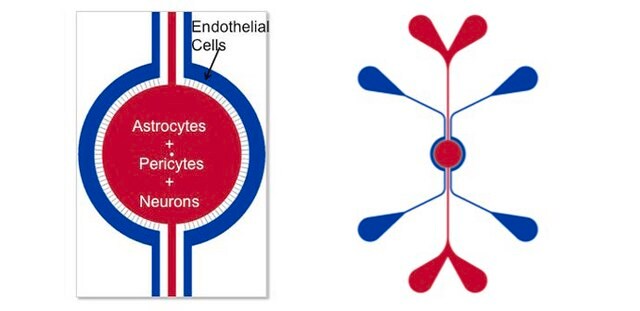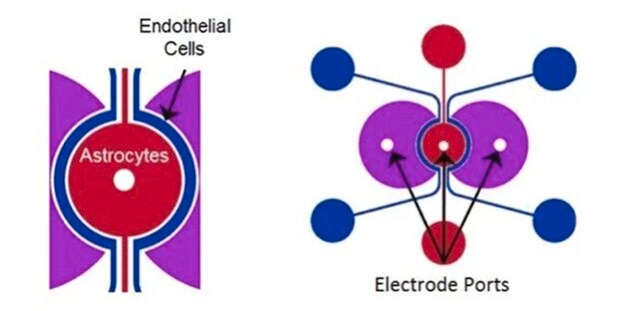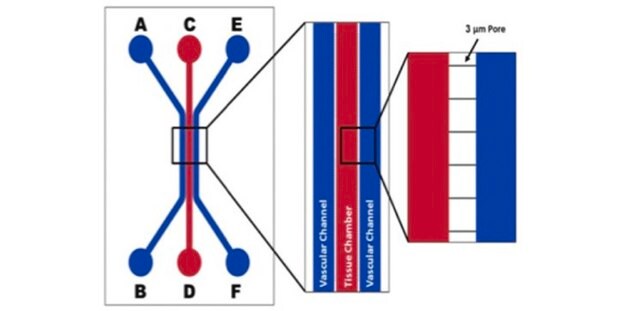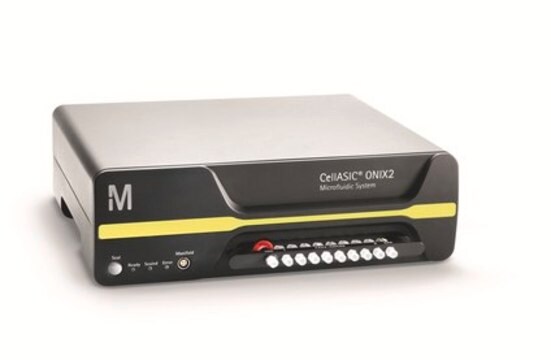VIV102015
SynVivo SynBBB 3D blood brain barrier model chip, Transepithelial/endothelial Electrical Resistance (TEER) configuration
Anmeldenzur Ansicht organisationsspezifischer und vertraglich vereinbarter Preise
Alle Fotos(1)
About This Item
UNSPSC-Code:
60104506
NACRES:
NA.84
Empfohlene Produkte
Verpackung
case of 1 ea
Hersteller/Markenname
SynVivo 102015
Lagertemp.
room temp
Allgemeine Beschreibung
SynBBB Blood Brain Barrier Model Chip - TEER configuration - Barrier type: Slits, Slit width: 3 μm, Distance between slits: 50 μm, Travel/barrier width: 50 μm, Outer Channel width: 200 μm, Device depth: 100 μm, Impedence measurement. This TEER enabled chip is used to create the SynBBB model in monoculture, co or tri-culture configurations.
SynVivo′s SynBBB 3D blood brain barrier model recreates the in vivo microenvironment by emulating a histological slice of brain tissue cells in communication with endothelial cells across the blood brain barrier (BBB). Shear-induced endothelial cell tight junctions, which cannot be achieved in the Transwell model, are easily achieved in the SynBBB model using physiological fluid flow. Formation of tight changes can be measured using biochemical or electrical analysis (assessing changes in electrical resistance) with the SynVivo Cell Impedance Analyzer. Interactions between brain tissue cells and endothelial cells are readily visualized in the SynBBB assay. Transwell models do not allow real-time visualization of these cellular interactions, which are critical for understanding of the BBB microenvironment.
SynBBB is the only in vitro BBB model that allows:
The SynBBB system is a highly versatile platform for investigation of:
SynVivo′s SynBBB 3D blood brain barrier model recreates the in vivo microenvironment by emulating a histological slice of brain tissue cells in communication with endothelial cells across the blood brain barrier (BBB). Shear-induced endothelial cell tight junctions, which cannot be achieved in the Transwell model, are easily achieved in the SynBBB model using physiological fluid flow. Formation of tight changes can be measured using biochemical or electrical analysis (assessing changes in electrical resistance) with the SynVivo Cell Impedance Analyzer. Interactions between brain tissue cells and endothelial cells are readily visualized in the SynBBB assay. Transwell models do not allow real-time visualization of these cellular interactions, which are critical for understanding of the BBB microenvironment.
SynBBB is the only in vitro BBB model that allows:
- Accurate in vivo hemodynamic shear stress
- Real-time visualization of cellular and barrier functionality
- Significant reduction in cost and time
- Robust and easy to use protocols
The SynBBB system is a highly versatile platform for investigation of:
- Tight junction proteins: Determine the levels of tight junction proteins namely zonula occludens, claudins and occludins which regulate the BBB.
- Transporter proteins: Analyze functionality of transporter proteins (e.g. Pgp) in normal and dysfunctional BBB.
- Drug permeability: Evaluate real-time permeability of therapeutics and small molecules across the endothelium of the BBB.
- Inflammation: Understand the underlying mechanisms of inflammatory responses on the regulation of the BBB.
- Cell migration: Visualize and quantify in real-time migration of immune cells across the BBB.
- Omic changes: Perform genomic, proteomic and metabolic analysis on normal and dysfunctional BBB.
- Neurotoxicity: Analyze toxicity effects of chemical, biological and physical agents on the cells of the BBB.
- Neuro-oncology: Investigate effects of the tumor cells on the BBB.
Verlinkung
LInk to Publications
application text
application text
Analysenzertifikate (COA)
Suchen Sie nach Analysenzertifikate (COA), indem Sie die Lot-/Chargennummer des Produkts eingeben. Lot- und Chargennummern sind auf dem Produktetikett hinter den Wörtern ‘Lot’ oder ‘Batch’ (Lot oder Charge) zu finden.
Besitzen Sie dieses Produkt bereits?
In der Dokumentenbibliothek finden Sie die Dokumentation zu den Produkten, die Sie kürzlich erworben haben.
Jez Huang et al.
Fluids and barriers of the CNS, 19(1), 38-38 (2022-06-02)
Human blood brain barrier (BBB) models derived from induced pluripotent stem cells (iPSCs) have become an important tool for the discovery and preclinical evaluation of central nervous system (CNS) targeting cell and gene-based therapies. Chimeric antigen receptor (CAR)-T cell therapy is
Unser Team von Wissenschaftlern verfügt über Erfahrung in allen Forschungsbereichen einschließlich Life Science, Materialwissenschaften, chemischer Synthese, Chromatographie, Analytik und vielen mehr..
Setzen Sie sich mit dem technischen Dienst in Verbindung.





